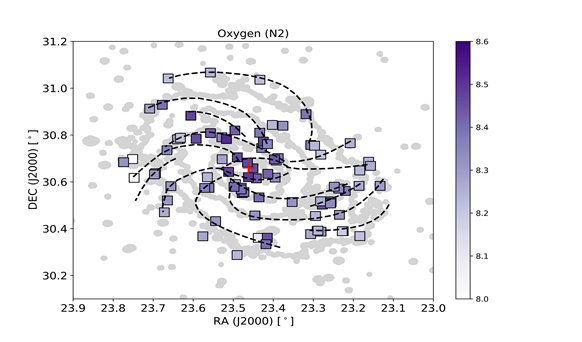Chemical History and Morphology of the Neighboring Galaxy M33 Revealed by LAMOST
M33, also known as the Triangle galaxy, is a neighboring galaxy moving towards the Milky Way with a radial velocity of around 180 km/s. Almost 100 yr ago famous astronomer Edwin Hubble noticed that the great angular diameter of M33 and its high degree of resolution provide an exceptional opportunity for investigation. Since that time, M33 is the most popular galaxy for astronomers for studying star formation processes, stellar evolution, galacto-chemical evolution, and the properties of the interstellar medium.
Using the spectra obtained with the Large Sky Area Multi-Object Fiber Spectroscopic Telescope (LAMOST) from 2011 to 2018 yr, a research group led by Prof Gang Zhao from National Astronomical Observatories of Chinese Academy of Sciences (NAOC) has presented morphological and chemical structures of M33.
The researchers obtained chemical composition of Helium, Nitrogen, Oxygen, Neon, Sulfur, Chlorine, and Argon in 110 gaseous nebulae in M33 and investigated the abundances as a function of galactocentric distance. The distribution of chemical elements is not homogeneous in the galaxy. The axisymmetric global distribution of chemical elements is negative, which means that at the center of galaxy the concentration of heavy elements, all elements heavier than helium, are higher than on the edge of the galaxy.
The researchers calculated the chemical gradients (the slopes), which will provide observational constraints on theoretical models of galactic evolution.
A total of 95 H II regions and 15 Planetary nebulae were identified in this study. Some of them were discovered and investigated for the first time.
HII regions are regions of interstellar atomic hydrogen that is ionized. They are formed around the most massive stars, which are hot enough to produce intense ultraviolet radiation that can ionize the gas around them.
Planetary nebulae are gaseous shells, which were expelled by dying star at the center of the nebula. This dying star can be, for example, a White Dwarf with very high temperature around 250,000 Kelvins, which cause the ionization of the previously ejected gaseous material, which becomes visible as a Planetary nebular.
The spectra of both HII regions and Planetary nebulae look like a forest of strong emission lines of different chemical elements. "The analysis of the strength of the lines allows to determine nebular properties such as temperature, density and chemical composition," said Dr. Sofya Alexeeva, the first author who is affiliated with NAOC.
"After careful spectral investigation, we also accidentally discovered one new Wolf-Rayet star classified as WC (carbon rich) candidate and one transition Wolf-Rayet WN/C candidate," said Dr. Sofya Alexeeva. "WN/C stars are indeed considered to be at an intermediate evolutionary phase from the WN to WC stages. Such kind of stars are rarely observed, because this transition period must be relatively short."
The researchers presented the grand-design pattern of the spiral structure of M33 by employing 519 HII regions collected from this study and literature.
"H II regions are the sites of recent massive star formation, and they are good tracers for the galactic spiral structure," said Dr. Sofya Alexeeva. "The presented pattern of the spiral structure of M33 will help to clarify the morphology of the galaxy."
The study was published in The Astrophysical Journal, and is available at https://doi.org/10.3847/1538-4357/ac38ab

Image: Spatial distribution of Oxygen in M33, where the abundances are shown by color bar. Dashed lines show the spiral arms of the galaxy designed in this study. (Credit: NAOC)